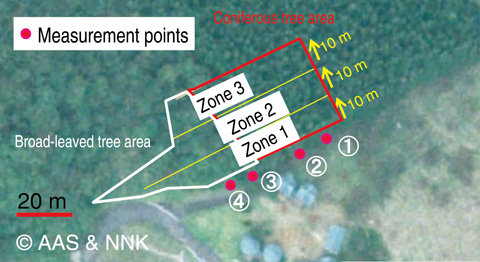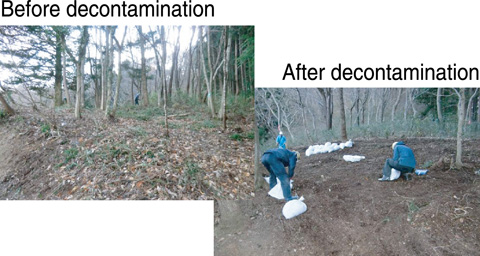
Fig. 1-13 Aerial view of test location

Fig. 1-14 Before and after photos of the test location
Table 1-2 Forest decontamination depths measured from the forest edge and the resultant reductions in air dose rates (1 m) at the forest edge

One of the most urgent issues following the accident at the TEPCO’s Fukushima Daiichi NPS was the remediation of the extensive areas contaminated by the radioactive materials discharged. In response to this situation, JAEA performed decontamination experiments at two test sites located in the Date and Minamisoma municipalities, combining a range of buildings and different types of land use, in order to accumulate knowledge and data for full-scale decontamination activities to be performed by local governments. We established a plan involving practical decontamination methods that can be easily implemented at each site according to the decontamination targets (e.g., forests, agricultural land, residential buildings, and roads). Here, we introduce the results of this field demonstration of forest decontamination.
It is considered important to reduce the exposure doses of people living in houses adjacent to contaminated forest, since most of Fukushima is covered with forest. In addition, it is necessary to obtain data related to the effectiveness of decontamination methods and appropriate decontamination conditions, e.g., the determination of the distance from the forest boundary that is sufficient for the development of effective and efficient decontamination.
To this end, mowing of grass, removal of fallen leaves and the litter layer, and trimming of branches were conducted sequentially in Zone 1 (up to 10 m from the forest boundary) of two areas: one covered with coniferous trees and another covered with broadleaved trees. Air dose rates at the forest boundary were measured after completion of each decontamination activity. This process was extended to a distance of 30 m from the forest boundary in increments of 10 m (i.e., Zone 2 and then Zone 3), but no branch trimming was implemented for Zones 2 and 3 because trimming of all the trees in these zones had been already done before the experiment (Fig.1-13, Fig.1-14).
As shown in Table 1-2, litter layer removal was most effective in reducing the air dose rate at the forest boundary. Overall, up to 50% reduction in the air dose rate at the forest boundary was obtained by decontamination in Zone 1, although no significant effects were obtained by further decontamination in Zones 2 and 3.
These results indicate that removal of litter layer within a distance of 10 m from the forest boundary can be most effective in reducing the exposure doses of people living in houses adjacent to a contaminated forest.
This work was commissioned by the Cabinet Office, Government of Japan.